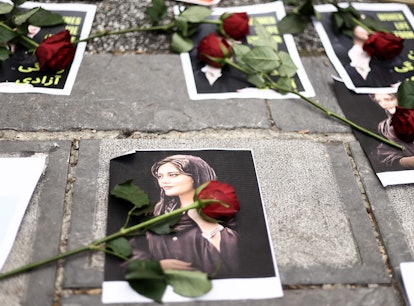
Here’s What To Know About The Hijab Protests In Iran
Protesters are chanting, “women, life, freedom.”
Across Iran, women are pushing back on laws requiring them to wear head coverings in public after the death of Mahsa Amini, a young Kurdish woman who died in police custody after being accused of violating the hijab law. Per The New York Times, Amini, 22, died on Sept. 16, just three days after her arrest by Iran’s "morality police,” formally known as Guidance Patrol, the group which enforces the country's rules on hijabs and other conservative Islamic modes of dress and behavior. While authorities say she died from a heart condition, her family rejects that, citing witness reports that she was beaten while in custody. Days after her death, widespread protests broke out on the streets demanding justice for Amini, and protesting the law she was arrested for. Here’s what else you should know.
According to The Washington Post, the case taps into long-standing anger against police brutality and other social issues. Videos of the protests show women burning their hijabs, cutting their hair, and chanting slogans like “women, life, freedom,” as well as protesters flipping and burning police cars. The demonstrations are reportedly the largest since 2019 protests against ending fuel subsidies.
Iran has a long history of accused human rights violations, according to Amnesty International, and particularly oppression of women. In Amini’s case, it comes down to the stringent laws on women’s attire: In Iran, where religious Islamic law is enforced, women over the age of 9 are required to wear a hijab, or head covering, in public. Hijab means “curtain” or “partition,” and is commonly used to describe the head covering of a Muslim woman, according to The Washington Post. While many Muslim women around the world voluntarily choose to wear a hijab, in Iran they have been required by law since the country’s 1979 religious revolution.
The events leading up to Amini’s passing in police custody are widely contested, with vague information from the police and doctors — much of which her family has disputed. Here’s what we know so far.
What Happened To Mahsa Amini?
On Sept. 13, Amini was on vacation with her family in Tehran, the nation’s capital, when she was detained and taken into police custody by the morality police. Amini was taken to a reeducation center for women who are arrested over dress rules. While in custody, Iranian authorities said she suffered a “sudden heart failure,” and died in a hospital in Tehran on Sept. 16 after spending three days in a coma, the BBC reported.
But her family apparently doesn’t believe that claim. Amini’s father Amjad Amini said to the BBC witnesses told his son, Amini’s brother, that she had been beaten in a van and at the police station, raising concerns of police brutality. Amjad also said he was denied access to his daughter’s autopsy report, and when he viewed her body, only her face and feet were visible, and her feet had visible bruising. Her family also denies authorities’ claims that she had serious preexisting medical conditions that could have contributed to her death.
Per the Post, edited surveillance video released by Iranian authorities showed Amini entering the reeducation facility appearing healthy, while a later image from another camera showed her slumped in a hallway. As of Sept. 23, Amini’s family is demanding the release of the unedited surveillance video.
What Is Iran’s Hijab Law?
Iran’s hijab requirement was instituted in stages after the 1979 Islamic Revolution, and in 1983 Iranian parliament made the hijab legally mandatory for all women and girls over the age of 9. Violators are subject to severe punishments, including fines, imprisonment, and up to 74 lashes. The Washington Post reported that Iran’s archconservative President Ebrahim Raisi has doubled down on enforcing the hijab law since taking power in 2021.
Prior to 1979, women in Iran didn’t have to wear a hijab and photographs show stylish women on the streets wearing western-influenced clothing. On International Women’s Day on March 8, 1979, over 100,000 women protested against the enforcement of hijab requirements.
The Protests Are Increasing
“This is Iran’s George Floyd moment,” British-Iranian actor Omid Djalili said in a video shared on Twitter. Women are burning their hijabs in protest, cutting their hair, and marching in demonstrations with signs that read, “We Are All Mahsa Amini.” CNN reported deadly clashes with police across towns and cities in Iran. At least 11 people have been killed as of Sept. 23, with that number still on the rise, according to a tally published by the Associated Press.
The protests continue to grow across the nation, as the discontent taps into other social issues that have long caused unrest in Iran, including economic hardship and tensions with the country’s Kurdish minority, per The Washington Post. In an attempt to curb the spread of protests, mobile networks have been shut down and access to Instagram and Whatsapp are being restricted. Anyone involved in “illegal gatherings” is under threat of prosecution, Bloomberg reported.
Hadi Ghaemi, executive director of the New York-based Center for Human Rights in Iran, told CNN on Sept. 21 that the protests were expanding. “This time protesters aren't only calling for justice for Mahsa Amini. They're also calling for women's rights, for their civil and human rights, for a life without a religious dictatorship,” he said.
Meanwhile, the protests are attracting international support: On Sept. 22, the U.S. Treasury Department announced sanctions on Iran’s Morality Police, saying in a statement, “These officials oversee organizations that routinely employ violence to suppress peaceful protesters and members of Iranian civil society, political dissidents, women’s rights activists, and members of the Iranian Baha’i community.” And in a Sept. 21 speech at the United Nations General Assembly, President Joe Biden said that the world community stood with “the brave citizens and the brave women of Iran who right now are demonstrating to secure their basic rights.”